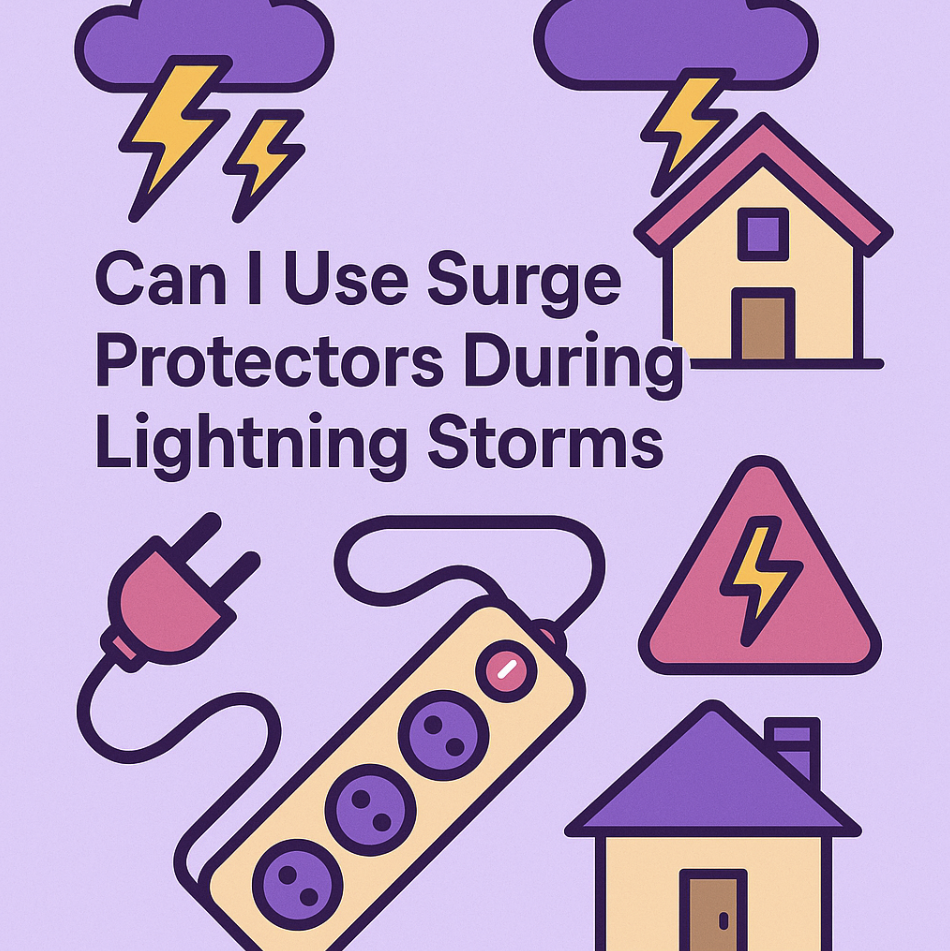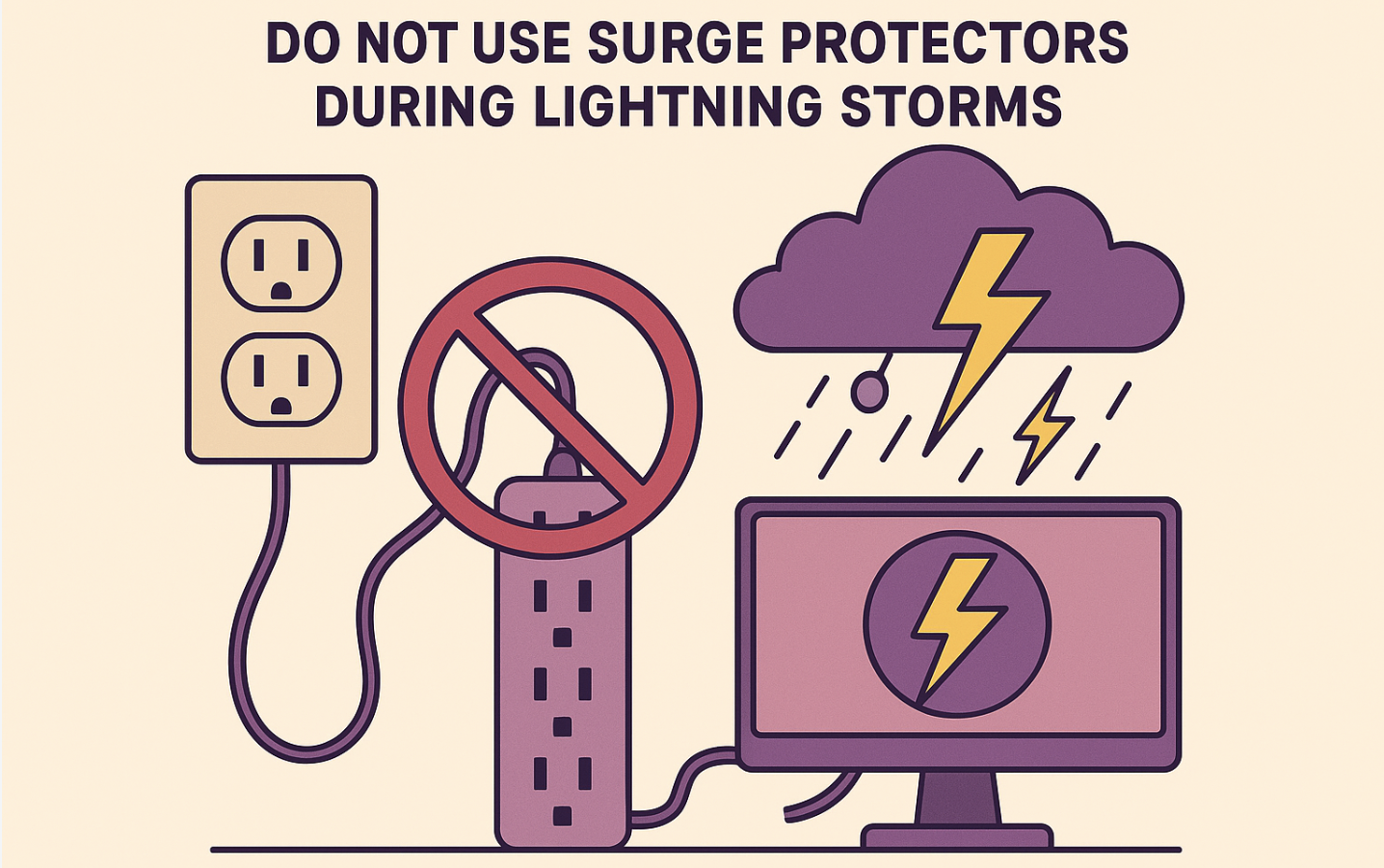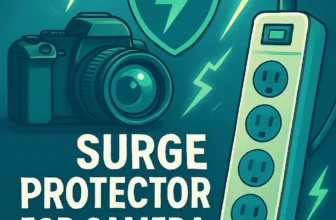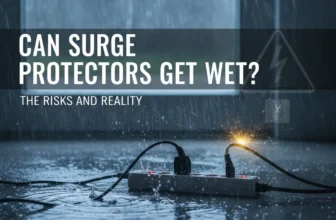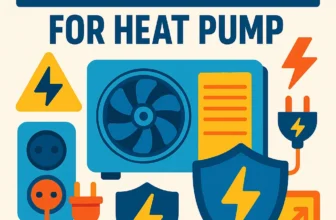Published By: Sean Hudson | Last updated on September 17, 2025 and reviewed by Editorial Team
When dark clouds gather and thunder rumbles across the sky, many of us instinctively reach for our surge protectors, believing they’ll shield our valuable electronics from nature’s electrical fury. This widespread belief, however, contains a dangerous misconception that could cost you thousands in damaged equipment and, more importantly, put your safety at risk. The relationship between surge protectors and lightning is widely misunderstood.
While these devices serve an important purpose in everyday electrical protection, their capabilities during severe weather events are far more limited than most people realize. This disconnect between perception and reality creates a false sense of security that electrical safety experts have been trying to address for years.
Understanding the True Purpose of Surge Protectors
Before getting into why surge protectors might fail during lightning storms, it’s essential to understand what these devices are actually designed to do. Surge protectors (sometimes called surge suppressors) serve as a defensive barrier between your electronic devices and the inconsistent power that can flow through electrical lines. In everyday situations, these devices excel at handling minor power fluctuations.
Imagine the small surges that occur when large appliances cycle on and off in your home, or when your utility company switches power grids. These relatively minor power variations typically range from 500 to 1,000 volts—well within the capacity of most consumer-grade surge protectors. Quality surge protectors contain components called metal oxide varistors (MOVs) that divert excess voltage away from your connected devices. When working properly, these components sacrifice themselves to protect your electronics, which is why surge protectors have a finite lifespan and require periodic replacement.
The Overwhelming Power of Lightning
The fundamental problem emerges when we consider the sheer magnitude of a lightning strike. While your surge protector might be rated to handle surges of a few thousand volts, a typical lightning strike delivers an entirely different scale of electrical force. To put this in perspective, a single lightning bolt can carry anywhere from 100 million to 1 billion volts of electricity. This astronomical amount of energy completely overwhelms even the most robust consumer-grade surge protectors, rendering them effectively useless against a direct or nearby lightning strike.
When lightning strikes near power lines, the electrical surge can travel along utility lines and enter your home’s electrical system. The resulting power surge is often too powerful and too fast for standard surge protectors to respond effectively.
In these situations, the surge protector itself becomes a victim rather than a defender.
False Security and Dangerous Misconceptions
Perhaps the greatest danger in relying on surge protectors during lightning storms isn’t just the potential for damaged equipment—it’s the false sense of security they provide. Many homeowners, gamers, and professionals working from home believe they’ve taken adequate precautions by plugging valuable electronics into surge protectors, when in reality, they remain highly vulnerable. This misconception can lead to complacency. Imagine continuing to use your computer during a severe thunderstorm, believing your equipment is protected, when in fact you’re putting both your equipment and potentially yourself at risk.
The surge protector’s presence may actually encourage riskier behavior during storms, paradoxically increasing the likelihood of damage or injury. Electrical safety experts consistently emphasize that no consumer-grade surge protection system can reliably protect against a nearby lightning strike. The physics simply don’t support the capability, regardless of marketing claims or price points.
What Actually Happens When Lightning Strikes
To truly understand the limitations of surge protectors during lightning events, it’s helpful to visualize what physically happens when lightning enters your home’s electrical system.
When lightning strikes near power lines or directly hits utility equipment, it creates a massive surge that travels along the electrical infrastructure. This surge can enter your home through power lines, phone lines, cable/satellite connections, or even through the ground itself. The electrical potential seeks the path of least resistance to ground, which often includes your home’s wiring and any connected devices.
At this moment, several things can happen to your surge protector:
- The surge may completely bypass the surge protection circuitry due to its speed and intensity
- The protective components may instantly fail, creating an unimpeded path for electricity
- The surge protector itself may overheat, melt, or even catch fire
- The excess energy may jump (arc) across components, defeating the protection mechanisms
In extreme cases, surge protectors themselves have become hazards during lightning strikes, causing fires or exposing users to electrical dangers. While modern safety standards have reduced these risks, they haven’t eliminated them entirely.
The Only Truly Effective Protection Methods
Given the limitations of surge protectors during lightning storms, what can conscientious homeowners, gamers, professionals, and travelers do to protect valuable electronics? The answer lies in a layered approach that begins with the simplest and most effective method: physical disconnection. Electrical safety experts universally agree that the only guaranteed protection against lightning-induced power surges is to completely unplug vulnerable equipment during storms. This means physically removing the power cord from the wall outlet—not just turning devices off or relying on a surge protector’s switch.
For those living in regions with frequent thunderstorms, this practice should become routine whenever severe weather is approaching. While it may seem inconvenient, the few minutes spent unplugging devices can save thousands in equipment replacement costs and prevent potentially dangerous electrical situations.
Beyond unplugging, a comprehensive protection strategy might include:
- Whole-house surge protection: These systems are installed at your electrical panel and provide a first line of defense against external surges. While still not lightning-proof, they can help with lesser surges.
- Proper grounding: Ensuring your home’s electrical system is correctly grounded according to current codes helps direct surges safely into the earth.
- Lightning rods: For homes in high-risk areas, a professionally installed lightning protection system can help direct lightning strikes safely into the ground.
- Uninterruptible Power Supplies (UPS): While primarily designed for battery backup, quality UPS systems often include better surge protection than standard surge strips.
The Particular Vulnerability of Connected Devices
In our increasingly connected world, lightning protection has become more complicated. Modern homes often have electronics connected through multiple pathways—power lines, ethernet cables, coaxial cables, phone lines, and more. Each connection represents a potential entry point for lightning-induced surges. Consider a typical home entertainment system: a television might be connected to power, cable/satellite, and perhaps ethernet for smart features. A gaming console connects to power, ethernet, and HDMI.
A computer system might have even more connections. Each of these paths needs protection, and a simple power surge protector addresses only one vulnerable point. This interconnectedness creates what safety experts call “back-door surges,” where lightning damage enters through unprotected pathways. Picture a scenario where you’ve carefully plugged your computer into a surge protector, but lightning enters through your cable internet connection instead, bypassing your surge protection entirely.
Professional and Gaming Equipment Considerations
For professionals working from home and serious gamers, the stakes are particularly high. These groups often invest thousands in specialized equipment that’s both valuable and sensitive to electrical damage. Professional equipment like high-end computers, networking gear, and specialized hardware often contains sensitive microprocessors and components that even relatively minor power fluctuations can permanently damage.
Gaming rigs with custom power supplies, graphics cards, and peripherals represent both financial and emotional investments that deserve proper protection. For these users, the inconvenience of unplugging equipment during storms must be weighed against the potential loss of expensive hardware and the data stored on these systems.
Cloud backups provide some protection for data, but they can’t replace custom hardware configurations or save the time invested in setting up specialized systems.
Travelers and Portable Electronics
Frequent travelers face unique challenges when it comes to lightning protection. Many carry portable surge protectors to hotels and temporary accommodations, believing these devices provide adequate protection regardless of location. However, unfamiliar electrical systems in hotels, rental properties, or international destinations may have unknown vulnerabilities or improper grounding, which can make surge protection even less effective.
Travelers often lack knowledge of the building’s electrical infrastructure and lightning protection systems. When staying in unfamiliar locations during lightning storms, the safest approach remains to disconnect devices completely. This is especially important in older buildings, rural areas, or regions with less robust electrical codes and infrastructure.
The Psychological Aspect of Surge Protection
There’s an interesting psychological component to our reliance on surge protectors during storms. The presence of these devices gives us a feeling of control in situations where we fundamentally have very little.
Lightning, with its unpredictable and powerful nature, represents a force beyond human control, which creates anxiety.
Surge protectors provide a comforting illusion that we’ve taken steps to mitigate this uncontrollable force. This psychological comfort may explain why the myth of surge protector effectiveness during lightning storms persists despite clear technical evidence to the contrary. Understanding this psychological aspect helps explain why many people continue using surge protectors in ways they weren’t designed for, despite warnings from manufacturers and safety experts.
The desire for protection often outweighs our willingness to accept the limitations of consumer technology.
Moving Beyond the Myths
Breaking free from misconceptions about surge protectors requires both education and a shift in perspective. Rather than seeing surge protectors as lightning shields, we should understand them as what they truly are: devices designed for everyday power management that provide a first line of defense against minor electrical fluctuations. This more accurate understanding doesn’t diminish the value of surge protectors—they remain essential components of electrical safety for protecting against the many smaller surges that occur regularly.
However, it does place appropriate limits on our expectations of what these devices can accomplish during extreme electrical events. By developing more realistic expectations and implementing truly effective protective measures during storms, we can better protect our valuable electronics and, more importantly, enhance our personal safety during severe weather events.
The next time storm clouds gather, remember that the most effective lightning protection isn’t found in a device you can purchase—it’s found in the simple act of disconnection. A few minutes spent unplugging devices provides peace of mind that no surge protector can match.

